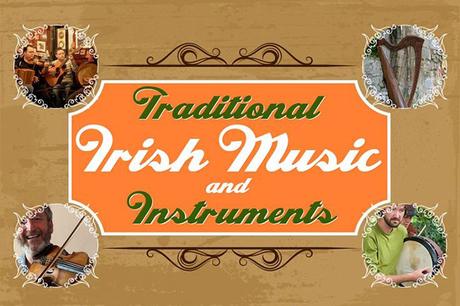
THE CELTS 500BC
•Traditional Irish music is an oral tradition whose origins can be traced back to almost 2,000 years ago when the Celts first arrived in Ireland.
•The Celts were established in Eastern Europe since 500BC and were heavily influenced by the music of the East.
•It is speculated that the Irish harp originated in Egypt.
THE RULING CHIEFTAINS 10TH TO 17TH CENTURIES
•The harp was the most dominant Irish instrument at this time.
•All harpists were professional musicians employed by the ruling Chieftains under a patronage system to create and perform music for them.
•In 1607 the Chieftains fled Ireland under pressure from invaders.
•It hugely affected the harpist’s tradition. They became ‘travelling’ harpists.
THE FIRST WRITTEN MUSIC – 18TH CENTURY
•The first written collection of Irish music appeared in 1762.
•It included 49 airs and was published by the Neale brothers in Dublin.
•The most significant manuscripts of Irish music from this time were created by Edward Bunting and unveiled at the Belfast Harp Festival of 1792.
•The manuscripts still survive today and are some of the most important documents in the history of the tradition.
THE GREAT FAMINE 1840s
•Over 2 million Irish people emigrated and ironically this resulted in helping to bring traditional Irish music across the world – particularly to the USA.
•Traditional Irish music networks were quickly established in cities with large volumes of Irish population such as New York, Chicago and Boston.
The Revival Recordings 1900s
•Recordings of Irish musicians were being made in the USA by the 1920s.
•These 78-RPM recordings made their way to Ireland and had a dramatic effect on the tradition. Musicians in Ireland began to speed up the tempo of the tunes.
•They also began to use the piano as an accompanying instrument to the fiddle and uilleann pipes, an idea previously unheard of.
Sean O’Riada’s Arrangements 1960s
•Traditional Irish music had its main setting in the houses and pubs of rural areas and music was played mainly to be danced to.
•Music lecturer Sean O’Riada opened the tradition up to a much wider audience. He set up the traditional musician ensemble ‘Ceoltoiri Chualann’.
•He used classical music forms, came up with a formula of playing solos within the group and his ensemble lead to the creation of ‘musical arrangements’.
•The group’s first concert took place in the Gaiety Theatre in Dublin. The tradition began to no longer be associated solely with rural areas and poverty.
The Golden Age 1970s
•Innovative developments included heavy influences of contemporary plus American and European folk, into traditional music. A new sound emerged.
•Groups that rose to fame included Planxty, De Dannan, and The Bothy Band.
•The popularity of these groups paved the way for certain traditional musicians to stand alone on stages throughout the world today.
Celtic Fusion 1980s +
•Ventures into new areas have included fusions of traditional Irish music with rock, reggae, punk, hip hop, jazz and new age.
•Popular artists that arose include Clannad, Sinead O’Connor, Enya, The Pogues, The Chieftains and Dropkick Murphys.
Music for Singing
Folk
Sean Nos
Caoineadh
Music for Dancing
Reels
Jigs
Hornpipes
Polkas
Traditional Irish Instruments
The Fiddle
•It looks identical to the violin, but its playing style and sound make it different.
•It is high-pitched, expressive, and played at a very fast upbeat pace.
•It is played with a bow and is thought to have been played in Ireland since the 17th century.
The Irish Flute
•It is a simple system transverse flute with six holes and up to eight keys.
•It is made of wood and produces a pure mellow sound that is completely unique to Ireland.
•The world famous melody “Danny Boy” is often played hauntingly on it.
The Tin Whistle
•It is a simple metal tube, with six holes and a mouthpiece with a range of two octaves. It dates back to the 12th century.
•It is also called a ‘penney whistle’ because of the whistles popularity among beggars and vagabonds on the streets of Dublin in the late 1500s.
•It is in the same category as the recorder, the Native American flute, and other wood-wind instruments.
The Celtic Harp
•The traditional Celtic harp was wire-strung and had no pedals.
•It was much smaller and originally held on the harper’s leg and leaned against the left shoulder.
•The ‘Trinity College Harp’, is one of the oldest surviving Celtic harps, dating back to the 15th century.
•The word ‘harp’ means ‘to pluck’. Today’s harp is much larger and rests on the floor. It is gut strung and includes pedals.
The Uilleann Pipes
•The meaning of these pipes translates to ‘pipes of the elbow’ because of their pump-operated bellows. They would have appeared in Ireland at the beginning of the 18th century.
•They are composed of a chanter which has a range of two octaves in the key of D and often has keys. It also includes three to four drones and regulators, extra pipes which can play certain chords.
•A ‘practice set’ is often used which has no drones or regulators.
•It is a complex instrument which can take years to master.
The Bodhran
•This is a large framed drum ranging from 25cm to 65cm in diameter and covered with stretched animal skin, typically goat skin.
•It is struck with a stick which is traditionally made from double-ended knucklebone to provide traditional music with a pulsating beat.
•The other side is open ended for one hand to be placed against the inside of the drum head to control the pitch and timbre.
Article contributed by Paul Murphy of www.murphyofireland.com
